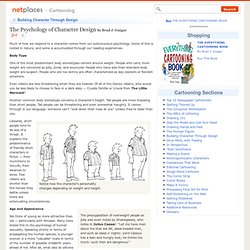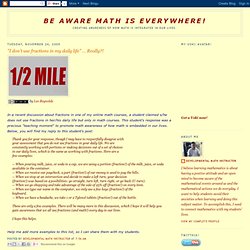

The Math Behind the Beauty. By M. Bourne Jessica Simpson What has mathematics got to do with beauty? Actually, a lot. How to Draw Chibi Bodies, Step by Step, Chibis, Draw Chibi, Anime, Draw Japanese Anime, Draw Manga, FREE Online Drawing Tutorial, Added by Jedec, December 2, 2010, 9:53:59 am. The Psychology of Character Design - Cartooning. Much of how we respond to a character comes from our subconscious psychology.

Some of this is rooted in nature, and some is accumulated through our reading experiences. Body Type One of the most predominant body stereotypes centers around weight. People who carry more weight are conceived as jolly, jovial, and avuncular. People who have less-than-standard body weight are suspect. Proper Proportions - Cartooning. Basic Cartoon Proportions. Basic Cartoon Proportions I put together the following tips for another artist and thought I'd share it with all.

Most of this is pretty basic stuff, but you might find it interesting. • The main element of measurement is the head. Once you've drawn that, everything else follows. • The older the character, the more "heads" tall they are. • Teens are about the same proportions as adults. Maybe they are a bit thinner or the *eye-level line is lower. (*Eye-level line is a horizontal guideline drawn on the face to indicate the placement of the eyes. On younger characters, the line is at or below the middle of the face. . • You also need to establish relative sizes between each character, i.e., Adults are one head taller than a ten-year-old, almost two heads taller than a six-year-old, etc. Tutorial: Anatomy and Proportion. Learning how to draw the Human Form efficiently and effectively takes a lot of time, practice and patience.

I don’t pretend to be a master of anatomically correct drawing, but I do attempt to consult my charts and references often when I am trying to establish a believable looking figure. Understanding the structure of the human body and its extents and limits is the key in creating forms that are lifelike and realistic in a relative sense – you could be doing life drawings and attempt to be infinitely realistic, or you may be making simplistic cartoons or caricatures which should have some semblance of being anatomically correct. There are many current and aspiring artists who neglect to refer to the basic fundamentals of anatomy and proportion and dismiss blatant errors as drawing in their own particular style.
Fraction Concepts. Comments: Repeating many activities, like the ones above, will help students understand the uses of fractions.

It will help prepare them for their higher math classes in higher grades. Activities like this will help them reason about the answers they get to arithmetic problems. By thinking about what fractions mean, they can look at their arithmetic and ask, "Does this result make sense? " "Can I take 1/2 a pizza plus 1/3 a pizza to get a total of 1/6 a pizza?
Encourage students to notice where they observe fractions in everyday life. Extra: Promoting Algebra Concepts with Fractions: Once students have got the idea of 1 being anything divided by itself, extend the pattern to include variables and arithmetic operations. FRACCIÓN. Www.tv411.org/sites/default/files/TGSUPP-Fractions.pdf. Be Aware Math is Everywhere!: "I don't use fractions in my daily life" ... Really?! By Leo Reynolds In a recent discussion about fractions in one of my online math courses, a student claimed s/he does not use fractions in her/his daily life but only in math courses.

This student's response was a precious "teaching moment" to promote math awareness of how math is embedded in our lives. Below, you will find my reply to this student's post: Thank you for your response, though I may have to respectfully disagree withyour assessment that you do not use fractions in your daily life. Www.ed.gov.nl.ca/edu/k12/curriculum/guides/mathematics/grade6/Unit_7_Fractions_final.pdf. Skillswise - Fractions. Middle School Ratio & Proportion Projects. Www.philomathma.com/GropiusBau.pdf. Golden Ratio in Art « Art School at Home. The golden ratio has been known and used since ancient times.

Its most common use by artists is to locate their centre of interest. The lines joining the golden section points of opposite edges of the canvas intersect at a spot that is considered to be the most visually pleasing, the “sweet spot”. Seurat and Turner, in the paintings below, have used this method to place their centres of interest: Other artists use the golden ratios or rectangles more directly, like Piet Mondrian. Some of the golden rectangles he included in the piece below have been outlined in red: The placement of the golden section intersections varies according to the proportions of the canvas. Most standard-sized canvases have a length:width ratio of between 1.2 and 1.4 to 1 (somewhat shorter than the “ideal” golden ratio of 1.618 : 1).
Among modern artists, Alex Colville is perhaps the best known for using the Golden Section and other geometric methods in planning the layout of his paintings.